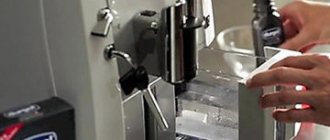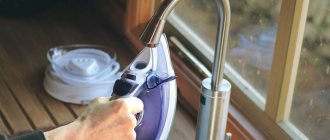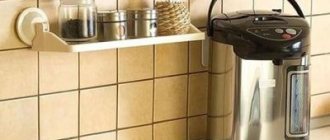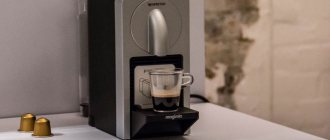Many owners of private houses and apartments install boilers to constantly have hot water. “Ariston” is one of the most popular brands of water heaters. The design of this technique is extremely simple and convenient. But, like all household appliances, the device requires periodic maintenance and cleaning. This ensures stable and long-term operation of the device. So we’ll figure out how to clean the Ariston water heater from scale at home.
Installing a hot water boiler is half the battle. It is important to provide regular care for it. Tap water, which contains an abundance of calcium, magnesium salts and other inclusions, is hard. The salts contained in tap water settle on the boiler parts and interfere with its normal functioning.
Important! If you neglect cleaning, the water heater will sooner or later fail. You will have to buy a new boiler, and this purchase is far from cheap.
To understand when it's time to clean your water heater, pay attention to the following points:
- The water began to heat up more slowly than before.
- The device turns off spontaneously and then turns on again. This is a very ominous sign, a signal to immediately clean the device from the accumulated scale.
- The device makes strange noises during operation. This is evidence that some parts of it are not working correctly.
- The water has acquired a foreign odor and an uncharacteristic dark hue.
- If you have been using the boiler for more than 1-1.5 years, then you need to clean it, even if the water heater is fully operational.
Important! Before cleaning the Ariston boiler, be sure to study its structure and circuitry, since the device will have to be disassembled.
How to know when it's time to cleanse
Installing a hot water boiler is half the battle.
It is important to ensure regular maintenance. Tap water containing an abundance of calcium, magnesium salts and other inclusions is hard
The salts contained in tap water settle on the boiler parts and interfere with its normal functioning.
Important! If you neglect cleaning, the water heater will sooner or later fail. You will have to buy a new boiler, and this purchase is far from cheap.
To understand when it's time to clean your water heater, pay attention to the following points:
- The water began to heat up more slowly than before.
- The device turns off spontaneously and then turns on again. This is a very ominous sign, a signal to immediately clean the device from the accumulated scale.
- The device makes strange noises during operation. This is evidence that some parts of it are not working correctly.
- The water has acquired a foreign odor and an uncharacteristic dark hue.
- If you have been using the boiler for more than 1-1.5 years, then you need to clean it, even if the water heater is fully operational.
Important! Before cleaning the Ariston boiler, be sure to study its structure and circuitry, since the device will have to be disassembled.
Boiler assembly
The boiler must be assembled in the reverse order of disassembly. After the boiler is assembled, do not forget to check the water heater for leaks. Fill the tank with water and leave for 24 hours. If it doesn’t leak, it means you did everything right.
The efficiency of its operation depends on how responsibly you approach cleaning the boiler. If you are not confident in your own knowledge and skills, it is better to contact a specialist.
Important! When disassembling the boiler, be sure to photograph or video the process. In this case, assembly will be much less labor-intensive.
Cleaning Ariston and Termex boilers
How and how to clean sewer pipes at home
Owners have many questions about how to clean a water heater of different brand models, for example, Ariston, Termex, and what features they have. You will learn about this below.
Actually, the process itself is not much different for all models and is carried out according to standard rules.
The first thing we will consider is how to clean an Ariston boiler at home. As with all other devices of this type, all work begins with disassembly.
In Ariston water heating equipment, the flange is attached differently. To disconnect it, you need to push the flask up, turn it clockwise in the container and pull it towards you.
The boiler and other components are cleaned according to standard items. Installation must be done step by step in reverse order.
An interesting video will show you how to clean an Ariston boiler using a screwdriver and two keys.
Cleaning the heating element and flushing the Termex boiler is carried out in the same standard way. is held once a year. In order to extend the service life of the tubular electric heater, a filter is installed.
You will learn how to clean a Thermex water heater from scale in the video.
Now you know how to clean an Ariston and Termex water heater
But after carrying out all the procedures, it is important to remember the following points: . Electricity can only be supplied if the container is completely filled with liquid.
Otherwise, failure to comply with the requirements may result in damage to the tubular electric heater. After complete assembly, you need to leave the boiler filled with water to function for another couple of hours. Be sure to do this under supervision, to ensure that the structure does not leak. At the end, the boiler must be flushed.
- Electricity can only be supplied if the container is completely filled with liquid. Otherwise, failure to comply with the requirements may result in damage to the tubular electric heater.
- After complete assembly, you need to leave the boiler filled with water to function for another couple of hours. Be sure to do this under supervision, to ensure that the structure does not leak.
- At the end, the boiler must be flushed.
All operations are carried out with the utmost care and caution so that there is no need for expensive repairs. .
How to clean a storage water heater with your own hands: ZOOM tips. Articles, tests, reviews
- Disconnect the boiler from the water supply, namely turn off the cold water.
- Unscrew the pipe from the fitting that releases hot water and connect the hose. Place the end of the hose into a drainage container (can be in a sink or bathtub).
- The next step will require disconnecting the pipe through which cold water flows. Water comes out of the hole.
- Then you need to remove the panel and power terminals.
- Disconnect the grounding and electrical wire. In order not to get confused and then install everything correctly in the reverse order, it is better to photograph the entire connection diagram.
- Then you need to unscrew the bolts and remove the flange with the tubular electric heater.
- If the water heater model is wall-mounted, carefully remove the structure from the mountings and place it on the fabric with the taps facing up. Loosen the clamping clamp and remove the tubular electric heater.
Modern water heating devices make human life much easier. But in order to extend the period of perfect operation of boilers, it is necessary to regularly monitor their condition.
Connecting the boiler after cleaning
Combination boiler
In order to reconnect the boiler, you need to do all the previous manipulations in reverse order. The assembled device must be checked for leaks, and, if the test is successful, water and electricity must be connected to it. In order to check the device for leaks, you need to let the filled water heater stand for 2-3 hours. If a leak is detected, the culprit is most likely the rubber flange gasket. You will have to spend some time searching for a gasket in a special store and then replacing it. When the boiler is connected to the power supply, you need to ensure that the thermostat is activated when the required temperature is reached.
If the heating element has not been cleaned for a long time, excessive scale build-up may render it unusable. In this case, all that remains is to replace it. When purchasing a new heating element, you should choose a similar device with the same power. You should immediately check the length of the contacts that are connected to the thermostat. We must not forget that improper cleaning of the heater can lead to electric shock and even explosion of the water heating device.
If a water heater leaks, you should pay attention to the magnesium anode, which is located near the heating element and is a metal rod. A magnesium anode is needed to initiate a chemical reaction that restores the protective layer of the internal walls of the boiler tank
During the operation of any boiler, the anode is destroyed and must be replaced. The service life of the anode depends on the intensity of use of the device. A leak indicates that the anode is faulty and requires replacement. In this case, you need to unscrew the anode and screw a new one in its place.
Removing scale from the heating element
So, the water has been drained, the next step is to separate the boiler from the wall. To do this, you will need an assistant, since the capacious Termex unit weighs a lot. You will need to disconnect the tubes, unscrew the nuts and remove the tank from the bracket, lifting it slightly. But now you can place the tank where it is convenient and begin dismantling the heating element.
Follow the steps of work sequentially:
- open the front cover by unscrewing the screws;
- take a photo of the location of the wires;
- disconnect the wiring;
- remove the support flange fastening and remove the heating element;
- Check the condition of the magnesium anode, it may be time to replace it.
The mounting of the heating element in boilers varies depending on the model and manufacturer. The nut on the Ariston heater is unscrewed and the corner is removed. The lid is loosened and inserted into the tank, the heating element is removed sideways. In other models, to remove the element, you need to turn it counterclockwise.
The main part of the contaminants from the heating coil is removed mechanically: under running water with your fingers or a plastic scraper. Citric acid works well against scale. Use a gentle cleaning method: cut off the neck of a plastic bottle and fill it with a solution of lemon juice in hot water, place the heater coil there for several hours. Periodically remove the part and remove the softened plaque.
You can clean it faster if you place the spiral in a deep frying pan with dilute acid on the stove and heat it over low heat.
Dissolving scale in acid
We disassemble the boiler
Boiler: features of choice
After draining all the liquid contained in the water heater and removing the device from the wall, it must be disassembled. How to disassemble the boiler before cleaning?
Follow the following instructions:
- First of all, you need to unscrew the bolts holding the front cover of the device.
- Then you need to remove the panel that is located near the thermostat.
- Removing the thermostat holder and protective door. A diagram will appear before your eyes - you need to photograph it with your phone.
- Disconnecting the electrical wire.
- Removing grounding.
Afterwards you can pull out the rubber seal and the heating element itself with the flange. Next you need to start cleaning.
Step by step instructions
Draining water from the boiler
The first thing to do is drain the water heater. To do this, you need to use the safety valve on the cold water supply, if it has a manual release handle, or turn off the hot water valve, then unscrew the reinforced hose from the cold water supply (if soldered, an American adapter) and open the second valve.
A boiler with a volume of 80 liters is emptied through a safety valve within 3 hours. In all other cases, the water flow is regulated manually using a previously preinstalled valve.
Removing the protective cover and disconnecting the temperature sensor supply
To do this you will need a shaped screwdriver. After unscrewing all the screws from the lid, the main mount to the seat of the heating element will open and access to the inside of the tank will open. As soon as the fastening is dismantled, overcoming the force of the sealing rubber, the heating element itself is removed, on the body of which an additional magnesium anode is installed.
Removing the tank
After all the above steps, the tank is removed from the wall. This is necessary for more thorough independent maintenance and high-quality cleaning under running water of accumulated dirt and salt deposits.
As soon as the tank is on the ground, a bucket of water is poured into it, after which the entire container is washed with an ordinary rag, and so on several times. After the surface deposits have been removed, you can begin to treat the scale-affected surfaces using one of the mentioned means. It is enough to follow the instructions and also avoid products that contain phosphates.
Cleaning the heating element from scale
The largest amount of scale deposits always concentrates on the walls of the heating element, simultaneously destroying the anode. After removing scale from this functional unit mechanically, the remains of the magnesium anode are removed to install a new one (replacement is mandatory).
As for the heating element itself, to fully clean it you will need to select any container, fill it with a previously used descaling agent, but at the same time exceeding the concentration by 3 or more times. The heating element is lowered into the prepared solution for the next 3-4 hours.
If you can’t wait 3 hours, you can heat the liquid solution or even bring it to a boil. An old electric kettle will also work for this. The fumes are extremely toxic, so you need to protect your respiratory system or leave the room altogether.
Such simple manipulations will help you completely get rid of scale in the shortest possible time, while returning the boiler to its previous efficiency and energy savings.
How to clean
There are several products that can be used to clean boilers.
Folk
People who do not want to use chemical detergents use folk remedies.
Vinegar
Acetic acid is an effective solution for cleaning your water heater. When creating a working mixture, you need to dilute vinegar with water in a ratio of one to three. Then moisten a sponge in the solution and wipe the surface with plaque.
Lemon acid
A cleaning solution made from citric acid will help remove scale and clean the surface of plaque. To prepare the mixture, you need to add 5-7 grams of acid to a liter of warm water. The liquid is thoroughly stirred until the citric acid is completely dissolved.
Soda with vinegar
Sometimes the boiler is flushed with a liquid made from vinegar and soda. When creating the product, add 100 milliliters of acetic acid and 80 grams of soda to a liter container of water. Then the walls of the water heater are washed with the solution.
Professional
To get rid of scale faster, use professional detergents.
Filtero
To remove scale and clean the inside of boilers, use Filtero. It comes in powder form, which must be dissolved in warm water before use.
Topper 3031
This product is designed specifically for cleaning water heating equipment from scale deposits. The features of this detergent composition include:
- effective plaque removal;
- absence of toxic components in the composition;
- ease of use.
Bagi Kumkumit
To combat corrosion and scale, you can use Bagi Kumkumit. This is a concentrated and effective composition that can restore the surface of boilers, coffee makers, kettles and even irons. Bagi Kumkumit should be used at least once a month.
"Melon ZhS17"
This product should be used if the boiler has not been cleaned for several years. "Melon" is considered a highly concentrated product that removes scale, traces of fungus, mold, corrosion and many other contaminants.
"Silit"
This is a universal cleaning composition that helps clean surfaces from stubborn dirty stains, rusty deposits and scale. The advantages of Silit include the fact that it can restore the original shine of the coating.
"Eona Bio"
"Eona Bio" is a high-quality cleaner used for washing household appliances. The components included in this powder allow you to quickly remove scale. Before use, a sachet of “Eona Bio” is diluted in a liter of water.
Bagi Schumanit
A popular detergent composition used by many housewives to remove grease stains and scale deposits. You can wash your water heater with Schumanit no more than twice a month.
"Solita"
To clean boilers and geysers, many people use the Solita cleaner. The product contains components that corrode even old scale.
What are the best products to use?
The basic rule for any product remains the absence of phosphates, which not only corrode the water supply tubes, but also negatively affect the internal protective coating or enamel coating. Among the most popular it is worth noting:
- Glutoclean (liquid substance for cleaning any coatings, including irons);
- Sano Anti Kalk Kettle;
- Tortilla;
- REDD Stirovit;
- InterTechKomplekt ANTINAKIPIN.
The principle of operation of all these funds remains the same
It is necessary to carefully treat the surface that is covered with scale, including paying attention to the dismantled heating elements. After this, after the period of time indicated on the package, the boiler tank is washed with several buckets of water and wiped with a rag.
If scale remains on the walls and, especially, the bottom, the process must be repeated, increasing the exposure time by another 10-15 minutes.
During the cleaning process, the contents of the boiler can be poured into the bathtub or washbasin, since descaling agents are selected for their environmental friendliness and neutral effect on all types of materials, including cheap acrylic.
When is it necessary to clean a water heater?
There are a number of signs that clearly indicate the need to descale the boiler:
- Increasing the heating time to a given temperature;
- Increased energy consumption;
- Heating the outer shell of the device;
- The occurrence of extraneous sounds during operation.
Coloring of heated water and loss of transparency also serves as a signal for immediate maintenance.
Important!
It is recommended to carry out complete cleaning of the water heater at intervals of 1.5 to 2 years, and in case of continuous operation, this period is reduced to 1 year.
Cleaning the tank
Before you start cleaning the inner walls of the tank at home, you should determine the degree of contamination by shining a flashlight inside. If the deposits are small, then you do not need to remove the water heater. To begin with, rinse it from the inside using a shower head, and then wipe the mucus off the walls with a cloth soaked in soapy water.
Do not scrub the tank with abrasives. This will lead to scratches that will cause corrosion of the material.
If the contamination is serious, then the tank is removed and cleaned with improvised means.
Algorithm of actions:
- mix vinegar with water in a ratio of 1:10;
- connect the hose to the drain fitting;
- use it to pour the prepared solution into the tank, while the hose should be higher than the boiler;
- the filled tank is left for a day;
- Afterwards, the solution must be drained and the inside walls rinsed with clean water.
You can also use the following composition: 5 g of citric acid for every liter of water.
Tips for disassembling the structure and cleaning a wet heating element
Before cleaning the boiler begins, the device must be disassembled by removing the heating element. To do this, first remove the decorative plate covering the contacts and the place where the element is secured. It can be screwed on or secured with latches. Having reached the internal elements, it is recommended to photograph them so that there are no problems with subsequent system recovery.
We disconnect all contacts, after which we take out the heating element
If the device has not been descaled for a long time, proceed very carefully. Accumulated dirt may prevent the heating element from being removed easily.
There is no need to pull it, it is better to try to carefully clear the deposits.
In most cases, layers of scale accumulate on the tubular part, and there is not much of it inside the tank. It is enough to run water to wash out everything unnecessary from the boiler itself. If you cannot clean the boiler this way, you will have to work with your hands. The main thing is not to try to make the process easier by using aggressive abrasives. You need to use only practice-tested safe products.
To clean the heating element itself from a layer of scale, it is necessary to carry out the following manipulations:
- We clean off the bulk of the dirt mechanically, using a knife or something similar.
- Next, in a tall glass made from a plastic bottle (just cut off the neck), dilute citric acid. For 2 standard sachets of powder, about 2 liters of warm water.
- We place the heating element in this structure for at least a day. This time will be enough for all the dirt to come off and the heating element to return to its original appearance.
After these manipulations, you can assemble the boiler, test it and subject it to further operation.
What you need to descale your boiler
- Curly screwdriver.
- Key for 10-12 (depending on the assembly - American, European).
- 17mm wrench for disconnecting reinforced water supply hoses.
- Bucket or any other container.
- Screwdriver with voltage indicator.
- Gloves.
- New protective magnesium anode (recommended to be replaced every year to reduce rust).
This list of tools and accessories is relevant for both wall-mounted and floor-standing models. Once there is no more water in the heater, its weight does not exceed 22.5 kg (any model), eliminating the need for outside assistance.
For cleaning, the mounted boiler must be removed and turned upside down to remove the heating element and assess the scale of the work. It is better to do this in a bathtub or other large container, after placing a soft cloth under the product to prevent deformation of the body.
How to get the heating element?
The process of removing the heating element must be very careful. This rule is especially important to follow if cleaning has not been carried out for a long time.
Significant accumulated deposits may not allow you to quickly remove the element , and sudden movements can cause damage.
Having taken out the heating block, it is also necessary to inspect the magnesium anode. If the degree of its depletion is close to the maximum, then it is advisable to immediately replace this element with a new one. Otherwise, after some time you will have to repeat the disassembly of the unit.
Expert advice
In order for you to be able to use your boiler longer, you need to adhere to several rules that will help you not destroy the device ahead of time.
Buy a water purification filter, which comes in two types:
- the reagent filter is based on chemicals that oxidize iron, manganese and hydrogen sulfide, thereby softening the water;
- a reagent-free filter converts substances into an oxidized form, which makes it possible for them not to settle on the surface; therefore, it is more expensive.
Reagent filter
Reagent-free filter
And a few more tips:
- change the anode regularly;
- use maximum temperatures to eliminate bacteria;
- to remove an unpleasant odor, pass its full volume through the tank once every two months;
- use a scale filter.
Boiler selection
Let's try to find the right option together. If you need to purchase a water heater for the kitchen and use it for washing dishes and cutlery, a volume of 10-15 liters will be enough for you so as not to heat water that we do not use.
For one person, 50-80 liters of water is enough, but a family will need a 100-liter model. The size of the room is also of great importance; if it is small, immediately discard the “pot-bellied” options.
Cleaning a boiler without outside help is not at all difficult, but still, do not forget about the consequences, since cleaning too late will bring you many complications. Another thing is if you carry out this procedure once a year, then your equipment will last a long time and you can save your money and time. Successful use and long service life!
When is the best time to contact a specialist?
The design of the boiler is not complicated, but not in all cases it is possible to cope with problems and clean it yourself. Calling a plumber is justified if there is a water leak or the device does not turn on.
A qualified specialist will carry out diagnostics using a special tester without disassembling the water heater. The malfunction of the heating element can only be determined using the device. If a part burns out due to scale, the technician will replace it. Repair of a failed tube is not carried out.
The cause of the malfunction may lie in the temperature sensor. If after the measurements it turns out to be faulty, you will have to purchase a new water heater.
The specialist will also inspect other systems and help identify faults. After repair, the boiler will be cleaned of deposits using mechanical or chemical methods. The choice depends on the customer and the volume of the tank.
Cleaning the boiler from scale means extending its service life and ensuring proper operation of all device control systems. Regular flushing of the water heater will prevent the formation of a dense layer of scale, which reduces efficiency. Experts recommend combining the chemical method with the mechanical method to achieve maximum results. Analysis is carried out once a year, treatment with chemicals every 3-6 months.
Blog author. Experience in the field of cleaning services - 11 years. I love cleanliness and order in all areas of life. Beloved wife, mother of 3 children and attentive housewife. I have tried in my practice all the methods listed on the site. glad to meet you











